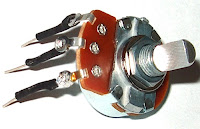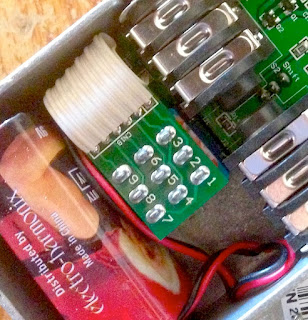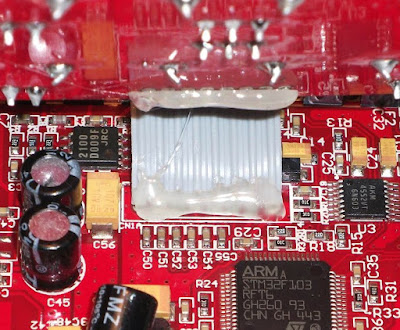I recently noticed that a page I referred to a lot just disappeared from internet... It is the Big Muff mods and tweaks page that was deleted recently.
Fortunately for us, there are some "internet archives" website that keep it alive for a while. In order to keep it alive, I added it here.
I also added a list of personnal mods that work quite well, and some notes about mods I already tried.
Easy mods
Diodes mods
The Big muff contains 4 diodes (2 pairs of diodes), that clip the signal to create gain, and compress the signal. Changing these diodes can change the compression and gain of the pedal drastically:
- Silicon diodes: these are the original diodes used in the Big Muff. Usually, they are 1n4148 type diodes, and gives the Big Muff reference tone: gainy, compressed yet crispy and tight distortion.
- Germanium diodes: germanium diodes will cut the sound more. You will have a more gainy, more compressed saturation, but also you will loose quite a bit of output volume. No germanium diodes were used in original Big Muffs.
- LEDs: LEDs are also diodes and can clip the signal. Red diodes clip more the signal compared to yellow, blue ones. There will be less gain, less compression and also more volume output. It gives to the Big Muff a nice "overdrive" feel, with a bit more dynamics. Note from Coda Effects: I tried it on this Big Muff variant, I really like it! It gives a lot of dynamics to the muff.
- FET / MOSFET: if you tie together the drain and gate of FET / MOSFET transistors, they will behave like diodes. Sound is similar to silicon diodes, a bit smoother.
- Remove the first pair of diodes, and you have got a Colorsound Supa Tonebender! The unit will be louder, with more bass, but still quite compressed. Great trick for bass players.
- Remove the two pairs of diodes: great trick! By removing the diodes from the unit now sound if fed back. Result: more volume (LOUD!), less compression, less gain and a more open (overdrive) sound. In my Dolmen Fuzz, I removed all the diodes with the central position of the switch: massive spurry sound!
A good way to see what is your favorite combination is to use sockets for the diodes. You can also use switches to change the diodes. Here is an example with silicon diodes and LEDs :
Works really well and it gives you multiples choices. With 2 of these on-on-on switches you can choose between no diodes or 2 different diodes set for each gain stage!
Emitter mod
Each transistor's emitter of the gain stages of the Big Muff is linked to the ground by a resistor (either 100R or 390R, R12 & R16). Removing the resistors will increase the "gainy-ness" of the pedal, increasing the resistors will lower it.
Resistor mod
Each of the gain stages has a limiting resistor on the start of it (R8 & R13). These are 8.2k (8k2) or 10k in different models. By diminishing these values the unit gets more gainy. (Note from Coda Effects: beware! There is a typo on the original Big Muff mods and tweaks text. Diminish it for more gain)
Creamy Dreamer
Basically the combination of the Emitter mod and the Resistor mod.
Noise gate mod
This mod will quieten the Muff while not playing, thus a noise gate. To do this, add a 100k trimpot (wired as a variable resistor) parallel to the 100k to ground of the second gain stage (R14). The trimpot can be adjusted to taste to get the max noise gate effect.
Coupling caps mod
The Muff has a lot of coupling caps (C1, 3, 4, 7, 16, 12 & 13). Coupling caps are next to the block of DC also a way to set the frequency response of the unit.
Enlarging these caps give the unit more bass, making em smaller give the unit more treble. Experiment with em. Also the sort of caps can make a difference in noise, feeling and authenticity. Old Muffs used ceramic coupling caps; using film caps here won't give you the same sound
High roll-off mod
Notice those small ceramic caps on 3 of the transistor stages? They are used to roll of excessive highs. Normally they are 470 pF (C2, 5 & 8) but larger values roll of more highs. You can also remove em for a great result.
Clipping caps mods
Next to the diodes is also a cap placed (C6 & 9). This cap determines the frequency band the unit clips. Enlarging this cap will make it clip more low notes, make it smaller for more high end clipping.
Transistor mods
The Muff uses four transistors and the type and choice of these transistors will affect the sound greatly. The higher the gain, the more the unit will focus on the high end / treble. Some known examples:
-
The Russian Muff uses E type transistors (newer ones use BC549C's though) which has a Hfe of around 500. I used BC184's as a great replacement of these transistors.
-
The NYC Muffs usually use 2N5088's or BC550's with a Hfe of around 800.
-
The Little Big Muff uses 2N5962 with a Hfe of around 1500 - 2000.
The Russian sounds darker due to the low gain. Knowing this, we can change the sound of a muff greatly by replacing the transistors. Small tip: use sockets when changing transistors. This way the transistors are not damaged by the soldering and swapping is much much easier. Some nice ones:
-
2N5133's: used in Triangle ones (the NOS versions tend to sound even better then newer ones) as FS36999's. Very nice sound, smooth, warm, open.One of my favs! Note from Coda Effects: I would not use these ones. They are really rare and expensive. I am not sure that they really sound better... I would try to find something similar in hfe (around 100-400).
-
BC239's: also used in a bunch of Muffs around. Slight less gain as the above named but this gives the Muff quite a nice touch.
-
2N5087's: PNP transistors instead of the above named NPN (more usualble). To use these you need to reorient some of the caps and change the + and - of the battery (called positive ground). Although they must be identical to 2N5088's they were used in some old models and do sound different.
-
BC141's: ultra low Hfe (around 100) and not suited for anyone out there. More bass, less gain but a very different sound.
-
MPSA13's: ultra high Hfe (around 10.000). Nice touch for some more gain.
Experiment! Use four of the same transistors or try to mix. For example I like a Muff with 5133's for the clipping stages and MPSA13's for the buffer stages.
Note from Coda Effects: I also experimented with a few transistors, here is my feedback about this:
- The first transistor is the one that will define the most of the gain of your unit. Higher hfe = more gain, but also more trebles... I tried a few ones:
- 2n5089: high gain, but also gives a "gritty" touch to the muff that I do not really like. Also quite noisy
- 2n5088: nice sound, gainy unit, but less noisy and agressive trebles than 2n5089. I really like it and use it often.
- 2n2222A: low gain, gives more bass and smoother sound. Beware: polarity is reversed compared to 2n5089.
- MPSA18: extreme gain! I would suggest to increase emitter resistor to limit gain (especially for noise issues), but you can have a nice "doomy" muff with it!
- 2n3904/BC549C: great for a low gain Muff.
- The two transistors of the gain stages play a bit more with compression. I usually use low hfe. 2n2222 are really nice for this use. 2n5088 can also do the job.
- The last transistor will define the final output volume of the unit. I like to have quite a lot of output volume, so I prefer to use high hfe transistor for the last stage, like 2n5089, or MPSA18.
Feedback mod
This mod is also not for anyone. It will give the Muff a weird drone note that will interact with the notes played resulting in octaves (up and down), nintendo sounds or a huge MUSH. Can sound quite nice and interesting!!!!! The mod is done with a feedback loop: connecting two points together and letting signal flow back. I found two of these loops in my Muff (note: more can be there; try for yourself!)
-
Connect the emitter of Q3 with the emitter of Q2 through a switch (so you can turn the loop off). The sustain will be on full when this mod is engaged.
-
Connect the collector of Q3 with the collector of Q1 through a switch. The sustain now can be varied by the sustain knob.
Great addition: add a 1M potmeter in the loop (wired as a variable resistor) or, even better!!, a LDR (light dependent resistor). With the latter, you can control the amount of feedback with the light on stage / with your foot shading the LDR from the light. Cool!
Note from Coda effects: this is really cool, but I will suggest to use a momentary footswitch. If not, you can be quickly bored with the noisy issues that will rise from this mod. However, from times to times (beginning of a song), it is a killer mod to use!
Pictures:
NYC muff:
 Russian muff
Russian muff:
(Note from Coda Effects: these units are getting rarer and rarer, I would not modify it)

Tonestack mods
The Big Muff Pi is legendary due to his tone section; only one knob to select between a bass, treble or in-between setting. The overall sound of this tone knob is the loved / hated mid cut.
Some Versions:
- Triangle version: R1=33k, C1=4n, R2=33k, C2=10n;
- Ramshead version: R1=33k, C1=4n, R2=22k, C2=10n;
- 1975 version: R1=39k, C1=4n, R2 = 22k, C2=10n;
- 1977 opamp version (1): R1=5.6k, C1=100n, R2=1.2k, C2=120n;
- 1977 opamp version (2): R1=8.2k, C1=100n, R2=1.2k, C2=120n;
- Green Russian version: R1=20k, C1=3.9n, R2=22k, C2=10n;
- Late model: R1=39k, C1=4n, R2=100k, C2=10n
- Reissue version: R1=22k, C1=3.9n, R2=22k, C2=10n;
- Little Big Muff version = reissue version.
And then some different mods:
- Swollen Pickle: R1=33k, C1=3.3n, R2 = 22k, C2=47n;
- Flat mids: R1=33k, C1=5.6n, R2=33k, C2=5.6n;
Tone stack bypass mod
By bypassing the tonestack the tonestack has no influence anymore on the sound thus does not color the signal in it's own way. Great way to get a more middy tone from your Muff. As the tone stack also cuts volume you get a huge volume increase
Tone stack complete mod
One of my most fav mods. Remove the tone stack altogether from the Muff and place a three band EQ circuit in it's place. Works like a charm and gives you more control over the sound! I also once added a Boss GE-7 in this place to give total control over the sound.
Read my post about the Big Muff tonestack for more infos about how the tonestack works and what mods you can do.
Bonus mods (Coda Effects)
Here are other easy mods and tweaks that can give a nice touch to a Big Muff:
Input Resistor / Capacitor:
The input resistor (R1) and capacitor (C1) defines how much signal enters the pedal, ie the overall gain of the unit. It also forms a filter that will allow some frequencies to go in or not.
Increasing the value of the resistor will lower the gain, and lower treble content of the pedal.
Increasing the value of the capacitor will increase the amount ot bass and the overall gain of the unit.
I like to use a switch to choose between a high gain bassy setting, and a lower gain treblier setting.
A smaller value in C1 also helps reducing noise. I used this mod on
this Big Muff for instance.
LPB1 before the muff circuit
Adding a LBP1 before the muff circuit can allow you to add an extra gain / bass amount to the muff. It really add some "heaviness" to the distortion. You can do it
on a veroboard, with a trimmer or external gain potentiometer. I want to use
the PCB I made recently to try this mod. The musket from Blackout Effectors uses this trick. With a simple 3PDT wiring, you can make it activable or not.
Germanium transistors in the distorsion stage
It can smoothen the Big Muff a bit, but remember to have a high gain last stage to recover enough volume. This is used in the Hoof fuzz from EQD. I am not super found of this mod, but you can try it out if you want! Remember to use NPN germanium transistors.
Voltage starver mod
You can emulate a dead battery, that will give a very peculiar sound to the muff: it cleans up a bit, and the circuit starts to sound "gated", and "stutters" a bit because it does not have enough power to work correctly. I would suggest to use this schematic:
Just connect the output voltage to the voltage input of your Big Muff.
18V Muff
Beware: I never tested it on a EHX, and I do not know if the stock pedal can handle 18V... If you have already test it, tell me. However, if you have made a clone with capacitors that can handle 18V or more, you can try to use a MAX1044 as a voltage doubler to supply your Big Muff with 18V instead of 9V!
Here it is! I hope that you liked it, good luck with experimenting!
If this article was useful, you can thank me by liking the
Coda Effects Facebook Page!























